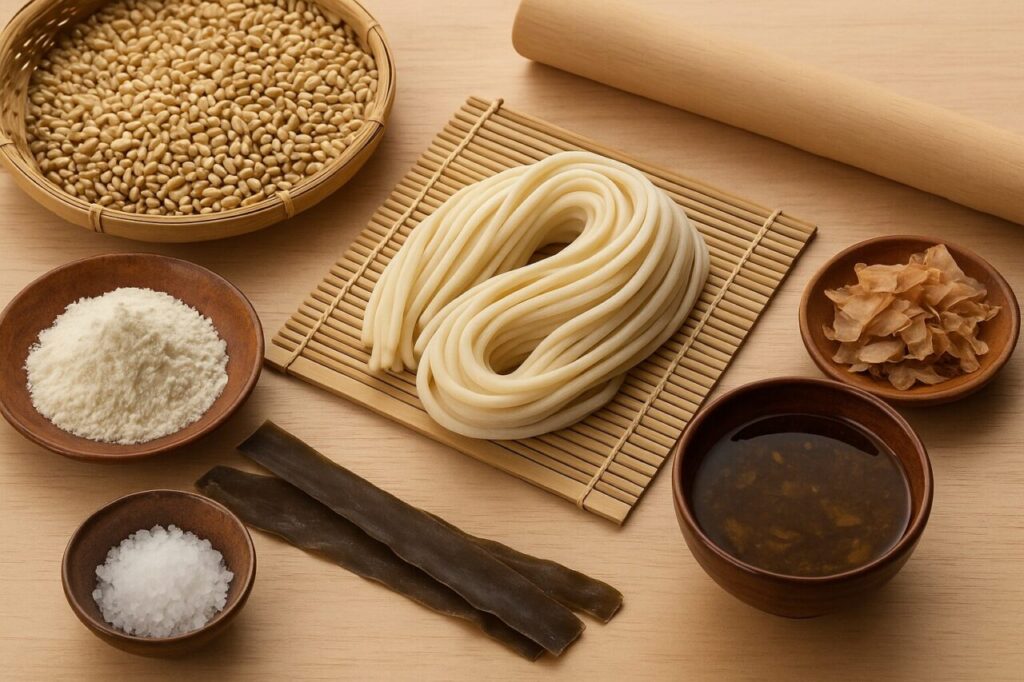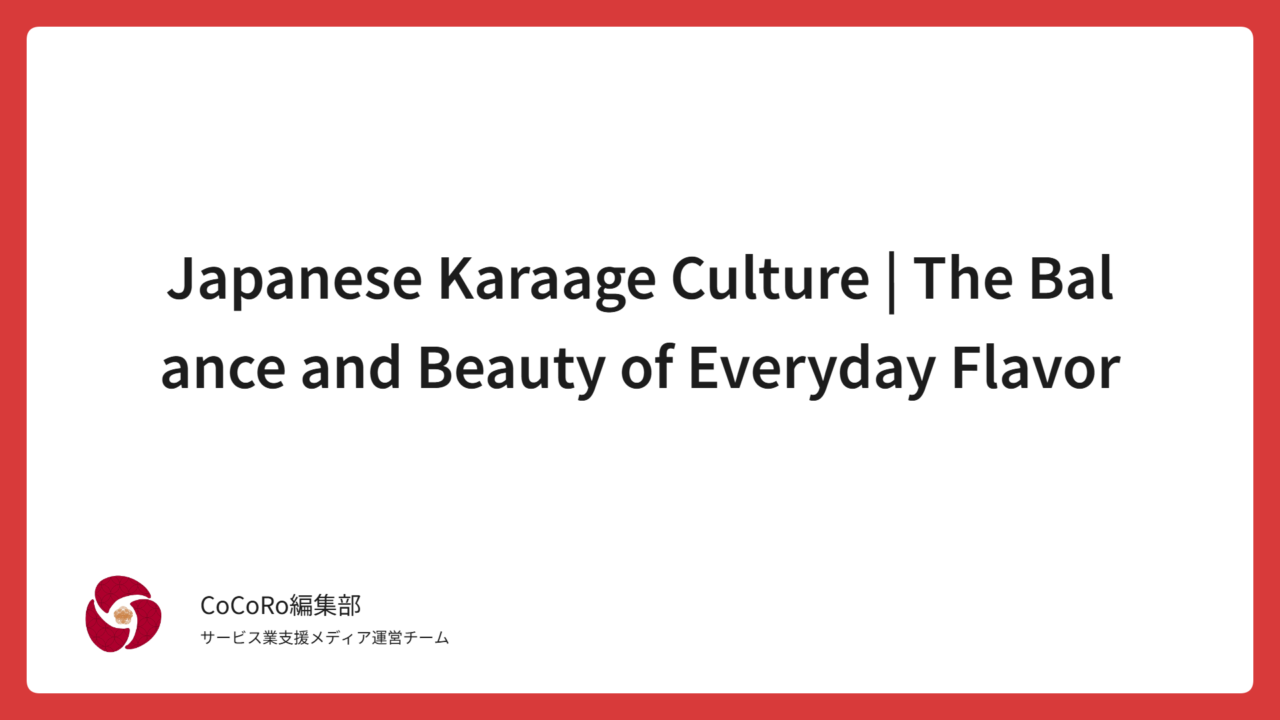

- Chapter 1: The Essence of Udon — Japan’s Staple Born from Flour, Water, and Salt
- Chapter 2: The History of Udon — How Japan’s Land Shaped Its Noodle Culture
- Chapter 3: The Smooth Taste of Udon — A Gift of Japan’s Water
- Chapter 4: The Culture of Dashi — The Subtle Art Behind Japan’s Flavor
- Chapter 5: Regional Varieties of Udon — How Climate and Culture Shape Flavor
- Chapter 6: Why Udon Culture Flourished Only in Japan
- Chapter 7: The Democratization of Udon — From Postwar Kitchens to Modern Diversity
- Chapter 8: Why Udon Is Loved Around the World
- Chapter 9: The Future of Udon — How Timeless Craft Becomes Culture
Chapter 1: The Essence of Udon — Japan’s Staple Born from Flour, Water, and Salt
Udon is a remarkably simple dish made from just three ingredients — flour, water, and salt.
None of these are rare or unique; they can be found anywhere in the world.
And yet, across Japan, udon has evolved into countless regional varieties, each with its own taste, texture, and personality.
From this quiet diversity, a rich and distinctly Japanese udon culture was born.
These differences are shaped not only by how the noodles are made or how the broth is prepared,
but also by the climate, the quality of the water, and the history of each region.
In other words, udon is a reflection of Japan’s natural environment and the accumulated wisdom of everyday life.
Udon is not a dish that was perfected through theory or invented by a single person.
It took shape gradually, as people adapted to local crops, weather, and the realities of daily life.
That is why every region in Japan has its own distinct character, each bowl carrying the taste of local wisdom passed down through generations.
Chapter 2: The History of Udon — How Japan’s Land Shaped Its Noodle Culture
The origin of udon is believed to date back to Japan’s Nara and Heian periods (8th–12th centuries),
when a Chinese wheat-based dish called bakutan (餺飩) was introduced.
However, the bakutan of that era was not a noodle dish like modern udon, but rather small pieces of dough, closer to dumplings.
At the time, wheat was an expensive ingredient, reserved for nobles and Buddhist monks,
and it had yet to appear on the tables of ordinary people.
Wheat did not become widely cultivated in Japan until the mid-Edo period (18th century).
Because the feudal tax system required farmers to pay their dues in rice,
they would turn to wheat and barley—crops that were not subject to taxation—as their own source of food.
In regions such as Kagawa, Okayama, and Hyōgo in the Setouchi area,
where rainfall was scarce and rice farming was difficult, wheat became an essential crop for survival.
People ground the wheat into flour, kneaded it with water, and boiled it to make a simple, filling meal.
This straightforward method gradually spread throughout rural Japan,
and in each region, it evolved into its own early form of udon.
In other words, udon did not begin as a luxurious dish,
but as a practical food born from everyday wisdom — a meal that sustained people’s lives.
Chapter 3: The Smooth Taste of Udon — A Gift of Japan’s Water
One of the key reasons Japanese udon has a texture unlike any other noodle in the world lies in its water.
Japan’s water is naturally soft, meaning it contains very low levels of minerals such as calcium and magnesium.
This softness allows the water to blend smoothly with wheat flour, producing noodles that are supple, elastic, and beautifully smooth in texture.
In contrast, much of Europe relies on hard water, which tightens the gluten in the dough and produces firmer, more elastic noodles — closer in texture to pasta.
In this way, differences in climate and water quality naturally gave rise to two distinct traditions: udon and pasta.
Another important factor is Japan’s high humidity.
The moisture in the air keeps the dough from drying out, allowing it to rest and mature over time.
Udon artisans carefully adjust the amount of water and salt each day according to the weather and humidity.
This process is guided less by theory and more by intuition — a form of craftsmanship that relies on experience and sensitivity.
Through generations of such fine-tuned practice, they have perfected the unique nodogoshi — the smooth, satisfying texture that defines Japanese udon.
Chapter 4: The Culture of Dashi — The Subtle Art Behind Japan’s Flavor
Another essential element that defines udon is dashi — Japan’s traditional broth.
Made from kelp, dried bonito flakes, sardines, and shiitake mushrooms,
dashi is a uniquely Japanese stock designed not to add flavor, but to draw it out.
It captures the delicate umami hidden within each ingredient, creating depth without heaviness.
In western Japan, particularly in the Kansai region, dashi is light and clear, centered around the delicate flavor of kelp.
In contrast, the Kanto region in eastern Japan favors a darker, richer broth made from dried bonito and sardines.
This difference is not simply a matter of taste—it reflects variations in water quality and historical trade routes.
Because the water in Kanto is slightly harder, flavors tend to blur, so locals compensate by using stronger soy sauce.
Meanwhile, Kansai’s soft water brings out the natural umami of kelp, allowing for a lighter, more refined flavor.
Japan’s dashi culture developed not from religion or aesthetic ideals,
but from the practical need to make the most of limited ingredients.
By using dried and preserved foods such as kelp and bonito flakes,
people could create deep, flavorful broths that lasted long and required only small amounts of material.
The broth used for udon was never a symbol of luxury — it was a product of economy, resourcefulness, and quiet wisdom.
Chapter 5: Regional Varieties of Udon — How Climate and Culture Shape Flavor
Across Japan, each region has its own unique local udon culture — styles of noodle-making that reflect the local climate, geography, and industries of the area.
Kagawa Prefecture’s Sanuki udon developed in a region with little rainfall and poor conditions for growing rice.
Instead, drought-resistant wheat was widely cultivated, and because the area had salt fields along the Seto Inland Sea, salt was abundant and freely used.
The Sanuki Plain was also dotted with reservoirs (tameike), which ensured a stable supply of water throughout the year.
Together, these natural conditions gave rise to udon with a firm, springy texture and a beautiful, translucent appearance — the signature of Sanuki udon.
Inaniwa udon from Akita Prefecture is a hand-stretched dried noodle that makes full use of the region’s cold northern climate.
By letting the noodles dry slowly in the crisp winter air, artisans achieve an exceptionally smooth and slippery texture — the hallmark of Inaniwa udon.
Goto udon from Nagasaki Prefecture is known for its unique method of using camellia oil to stretch and smooth the noodles.
Living on an island with limited natural resources, locals developed this practical and ingenious technique,
turning what they had into a defining feature of their regional cuisine.
In this way, the many regional styles of udon were not created out of a deliberate pursuit of flavor,
but as the natural outcome of people experimenting with what their land and climate allowed.
Each local udon is, in essence, a record of its region’s environment, labor, and way of life.
Chapter 6: Why Udon Culture Flourished Only in Japan
With just flour, water, and salt, it should be possible to make a noodle dish like udon anywhere in the world.
And yet, few places outside Japan have created noodles with the same softness and gentle harmony between noodle and broth that define true udon.
One reason lies in Japan’s unique combination of water quality and climate.
In regions with hard water, the dough becomes too tight, preventing the soft elasticity that gives udon its distinctive texture.
In dry climates, the dough tends to crack easily, making it difficult to rest and mature for long periods —
a process essential to the smoothness and depth of true udon.
Another reason lies in the philosophy of flavor itself.
In Europe, a culinary tradition of addition developed — building richness by layering sauces and seasonings.
Japan, on the other hand, cultivated a culture of subtraction, one that draws out the natural taste of ingredients and harmonizes them with water and dashi.
Udon perfectly embodies this “subtractive” approach to Japanese cuisine — a quiet pursuit of balance rather than excess.
Udon did not arise simply from Japanese diligence or craftsmanship.
Rather, it grew naturally from the land itself — a culture that emerged because Japan’s geography and climate happened to provide the perfect conditions for its creation.
Chapter 7: The Democratization of Udon — From Postwar Kitchens to Modern Diversity
The decisive turning point that made udon a nationwide dish came after World War II, during Japan’s postwar food shortage.
With rice supplies unstable, the government encouraged the consumption of wheat-based foods such as bread and udon.
Using flour imported from the United States under postwar aid programs, udon became a staple of everyday life across the country.
As milling and freezing technologies advanced,
dried and frozen udon became widely available, making it easy to prepare at home.
Soon, udon could be found everywhere — in stand-up noodle shops, school lunches, and company cafeterias.
It was no longer a special meal enjoyed on occasion,
but an everyday food woven into the rhythm of Japanese life.
Today, new styles of udon have taken root, inspired by international cuisine and the tastes of younger generations —
dishes like kamatama udon with raw egg, carbonara-style udon, and mentaiko cream udon made with spicy cod roe.
Far from breaking tradition, these innovations show that udon is a living cuisine —
one that continues to evolve and adapt with the times.
Chapter 8: Why Udon Is Loved Around the World
The reason so many foreign visitors respond warmly to udon is simple.
It is mild, gentle in flavor, and easy to digest — yet still rich with the deep umami of dashi broth.
This sense of calm and comfort is what makes udon so reassuring and appealing to people from all over the world.
Another reason for its appeal is that both the ingredients and the preparation are simple,
making udon less affected by religious or cultural differences.
In recent years, phrases like “Japanese Udon” and “Japanese Comfort Food” have become familiar across Europe and the United States,
where udon is gaining popularity as an everyday Japanese meal — lighter and more approachable than ramen.
What people around the world appreciate about udon is not its flashiness, but its calm, comforting taste.
It embodies a sense of culinary comfort that anyone, regardless of country or culture, can relate to.
Chapter 9: The Future of Udon — How Timeless Craft Becomes Culture
Today, instant and frozen udon continue to evolve,
allowing people to enjoy noodles at home that come remarkably close to the flavor of those made by skilled artisans.
At the same time, there are craftsmen who remain devoted to preserving handmade and regional styles of udon.
Even in an age of AI and automation, the ability to feel the dough by hand and sense the subtle shifts in humidity
is a skill that no machine can truly replicate.
Udon has never been a luxury dish; it has always been a food woven into everyday life in every era.
Its very simplicity may be what gives it enduring strength as a cultural tradition.
The history of udon is not a record of pursuing someone’s ideal,
but a record of people who faced reality and kept refining their craft through everyday ingenuity.
That, perhaps, is why udon has been loved for more than a thousand years —
a quiet testament to the resilience and creativity found in ordinary life.
✅ Closing Reflection
The story of udon is one of reality, not idealism —
a chronicle of perseverance, adaptation, and quiet ingenuity.
It reminds us that the true strength of Japanese food culture lies not in perfection,
but in the willingness to embrace reality and keep improving, one thoughtful step at a time.






